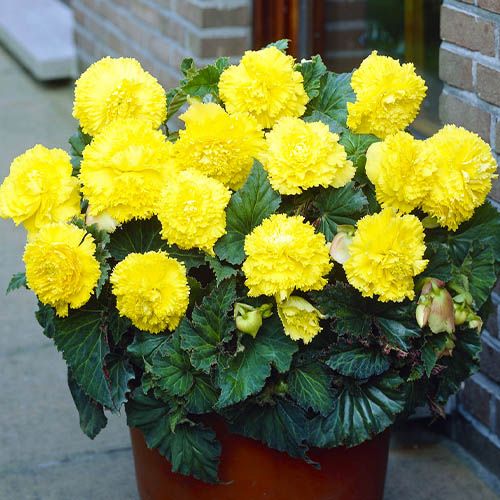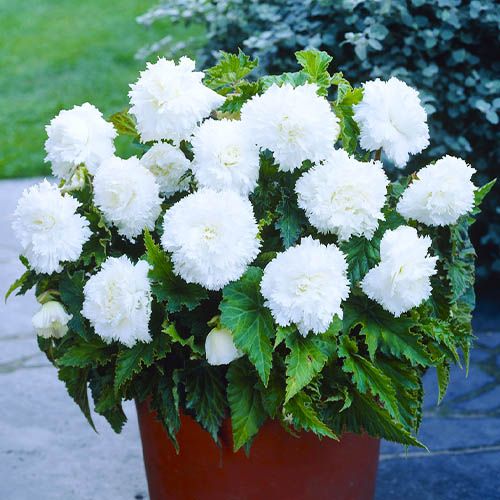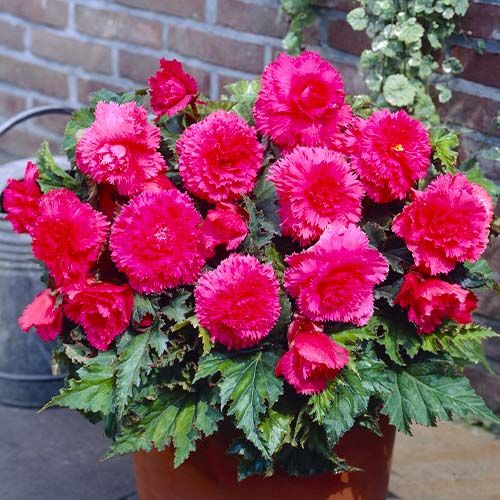Fimbriata Begonias
Fimbriata Begonias
Last Reviews
Introduction
If youre searching for a method to bring color and beauty to your yard, Fimbriata Begonias are a good option. These are tuberous begonias with enormous, beautiful blooms with fringed petals. They may bloom from summer through autumn and come in a range of hues ranging from white to pink to red to yellow. Fimbriata Begonias are simple to cultivate and maintain, and they may be planted in pots or baskets. This article will teach you how to choose, plant, and care for Fimbriata Begonias, as well as how to reproduce them and deal with typical issues. By the conclusion of this article, you should be able to acquire Fimbriata Begonia bulbs from our online shop and enjoy these lovely blooms in your own garden.
Choosing Fimbriata Begonia Bulbs
The first step in cultivating Fimbriata Begonias is selecting the appropriate bulbs for your environment. You may get Fimbriata Begonia bulbs from our online shop, which has a large range of high-quality bulbs at reasonable rates. Here are some suggestions for selecting Fimbriata Begonia bulbs:
- Look for solid, plump bulbs that are free of mold or injury. Avoid soft, shriveled, or rotting bulbs.
- Select bulbs that contain at least one or two buds or eyes. These are the sites from which the stems and roots will sprout.
- Choose bulbs that are the same color and size as the blooms you want. Fimbriata Begonias feature single or double blooms that vary in size from 4 to 8 inches.
- Keep the bulbs cold and dry until youre ready to plant them. You may also keep them in the refrigerator for up to three months if they are not frozen or exposed to ethylene gas from fruits and vegetables.
Planting Fimbriata Begonias
The best time to plant Fimbriata Begonias is in the spring, after the last frost date in your area. You can also start them indoors about 6 to 8 weeks before the last frost date and transplant them outside when the weather is warm enough. Here are the steps for planting Fimbriata Begonias:

1. Prepare the soil. Fimbriata Begonias prefer well-drained, rich, and slightly acidic soil. You can amend the soil with compost or peat moss to improve its texture and fertility.
2. Choose a location. Fimbriata Begonias need partial shade to full shade, as they do not tolerate direct sunlight well. They also need protection from strong winds and heavy rain.
3. Dig a hole. The hole should be about 3 inches deep and wide enough to accommodate the bulb.
4. Place the bulb in the hole. The bulb should be positioned with the buds or eyes facing up. If you are not sure which side is up, you can plant the bulb sideways.
5. Cover the bulb with soil. Gently press the soil around the bulb and water it well.
6. Space the bulbs about 12 inches apart. This will allow enough room for the plants to grow and spread.
Caring for Fimbriata Begonias
Fimbriata Begonias are not very demanding plants, but they do need some basic care to thrive. You need to water regularly. Fimbriata Begonias need moist but not soggy soil. Water them when the top inch of soil feels dry to the touch. Avoid overwatering or underwatering them, as this can cause root rot or wilting. Fimbriata Begonias benefit from a balanced fertilizer applied once a month during the growing season. You can use a liquid or granular fertilizer diluted according to the label instructions.
Deadheading is the process of removing faded or spent flowers from the plant. This will encourage more blooming and prevent seed formation. Pruning is the process of cutting back stems or leaves that are damaged, diseased, or overgrown. This will improve the appearance and health of the plant. You can prune Fimbriata Begonias in late winter or early spring, before new growth starts.
Propagating Fimbriata Begonias
If you want to increase your collection of Fimbriata Begonias, you can propagate them from seeds or stem cuttings. There are methods for propagating Fimbriata Begonias that you can use.
You can collect seeds from Fimbriata Begonias that have been allowed to produce seed pods. The seeds are very small and need light to germinate, so do not cover them with soil. Sow them in a sterile seed starting mix and keep them moist and warm. The seeds should germinate in about 2 to 3 weeks. You can transplant the seedlings when they have at least two pairs of true leaves.
You can take stem cuttings from Fimbriata Begonias in late spring or early summer, when the plants are actively growing. Cut a 4 to 6 inch stem with at least one leaf node and remove the lower leaves. Dip the cut end in rooting hormone and insert it in a pot filled with moist potting mix. Cover the pot with a plastic bag or dome to create a humid environment. Place the pot in a bright but indirect light and water as needed. The cutting should root in about 4 to 6 weeks. You can transplant the cutting when it has developed a strong root system.
Common Problems and Solutions
Fimbriata Begonias are generally resistant to most pests and diseases, but they can still encounter some problems. Here are some common problems that may affect Fimbriata Begonias and how to solve them:
1. Powdery mildew. This is a fungal disease that causes a white or gray powdery coating on the leaves and stems. It is more likely to occur in humid or crowded conditions. To prevent it, avoid overhead watering and provide good air circulation around the plants. To treat it, spray the infected parts with a fungicide or a solution of baking soda and water.
2. Aphids. These are small, soft-bodied insects that suck the sap from the plants and leave behind sticky honeydew. They can also transmit viral diseases to the plants. To prevent them, inspect the plants regularly and remove any infested parts. To treat them, spray the plants with insecticidal soap or neem oil.
3. Snails and slugs. These are slimy creatures that feed on the leaves and flowers of the plants, leaving behind holes and trails of slime. They are more active at night or during rainy weather. To prevent them, use barriers such as copper tape or diatomaceous earth around the plants. To treat them, handpick them off the plants or use baits or traps.
Conclusion
Fimbriata Begonias are an excellent option for adding color and charm to any garden. They are simple to cultivate and maintain, and they produce beautiful blooms with fringed petals that may endure for months. They also come in a number of colors and sizes, allowing you to select one that meets your preferences and available space. Fimbriata Begonia bulbs may be purchased from our online shop, where we provide high-quality bulbs at low costs. Order yours immediately so you may enjoy these lovely blooms in your own yard. If you are interested in these enchanting flowers, we recommend checking out fragrant begonias.
















